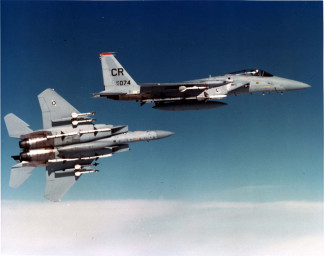
Johns Hopkins UniversityEst. 1876
America’s First Research University
Great Pilots and Great Machines: A Look into Steven Fino's Book "Tiger Check"

In early 1952, LIFE magazine published an eight-page, illustrated spread charting the remarkable transformation in American military aviation. In less than four decades, the fabric-covered, propeller-powered biplanes that once tussled over the Western front had given way to the sleek, jet-powered fighters battling over the Korean peninsula in a sliver of sky known as MiG Alley. The older fighters, the editors at LIFE explained, were “simply a flying gun platform.” The newer fighters, however, came crammed full of American technological ingenuity, which would soon allow the human pilot to use the “electronic ‘brain’” of his aircraft to aim futuristic, rocket-powered missiles. The editors believed that this technological transformation would demand a corresponding metamorphosis of the human pilot operator. They captioned their illustrations, “Fighters: Aces to Flying Scientists.”
Indeed, change was afoot, and the fighter pilots knew it. They had been lured into the air service with imagery of gallant knights and headlines trumpeting derring-do individualism, but the newly emerging gunsights, radars, and guided weapons now threatened to subordinate the historic role of the heroic pilot. One cartoon published in the fighter pilots’ professional journal in 1959 reflected the pilots’ apprehensions. In it, a decrepit troglodyte cowers inside a small container, a limp cable capped with a 10-prong plug resting beside him. The caption reads, “Black Box to Replace Pilot.”
When I started flying the F-15 in 1999, the fighter pilots’ pessimistic attitudes toward advanced, automated fire control technologies had largely dissipated. Successfully using a long-range radar to prosecute a simulated missile attack against an adversary aircraft had become the hallmark of a victorious training mission, and we spent countless hours reviewing and critiquing each other’s radar employment. We occasionally heard the graybeards in the bar lambasting the service’s singular enthusiasm for missile technology during the Vietnam War, but the lessons from that experience, we were told, were that fighter pilots were essential, that while we might focus on long-range missile volleys we should never sacrifice training for close-combat dogfighting, and that it was our duty to ensure that any future fighter aircraft came equipped with a gun because our missiles would inevitably fail at the most inopportune time. Despite the advanced fire control system’s primacy in our F-15 fighters, we didn’t consider ourselves flying scientists, and we knew that we had not yet been replaced by black boxes. Rather, we still considered ourselves the proper descendants of the mythical fighter pilots of the past—men like Eddie Rickenbacker, Richard Bong, and Robin Olds.
The fact that the skills we relied on to score aerial victory bore little resemblance to those used by our forebears was rarely acknowledged, if recognized at all. One former fighter pilot I interviewed for this book perfectly captured the subtle transformation that had taken place. In the past, he said, employing a fighter was synonymous with flying a fighter. But with the advent of new fire control technologies that both simplified the physical requirements of flying and simultaneously increased the cognitive demands on the fighter pilot, the two were no longer coincident. With each successive generation, fighter pilots had become less physical stick-and-rudder actuators and more “systems operators” and “information integrators.” As this transition in fighter pilot skills occurred, the very technologies that the pilots once feared would push them out of the cockpit instead became increasingly reliant upon them and their human capabilities remaining in the cockpit.
Regrettably, this co-evolution of human and machine in the fighter cockpit is often obscured. Popular histories tend to favor either the “great pilots” or the “great machines,” with precious little discussion of the critical nexus of the two. This book bridges the two narratives, revealing how fighter pilots could both shape and be shaped by the new technologies thrust into their cockpits. From this perspective, the history of the fighter pilot also provides insights into our struggles with the very concept of technological automation. What should be automated? How should it be automated? How will the automation alter the human operators’ tasks and skills? And how will the operators respond?
Today, we are routinely confronted with bold prognostications warning that tomorrow’s automated, electronic equipment, enriched with new machine learning algorithms and artificial intelligence designs, will upheave whole industries and technologically displace millions of human operators. The history of the fighter pilot and the juxtaposition of the LIFE headline, extolling the promises of automation, with the pilots’ own pessimistic cartoon reminds us that these tensions are not new, and that we have an obligation to continue wrestling with the same questions confronted by the engineers and fighter pilots of the past.
Steven Fino
Note: The views expressed herein are those of the author and do not reflect the official policy or position of the United States Air Force, Department of Defense, or the US Government.
Steven A. Fino is a US Air Force command pilot and a graduate of the Air Force’s Weapons School. He is currently assigned to the Pentagon. He is the author of "Tiger Check: Automating the US Air Force Fighter Pilot in Air-to-Air Combat, 1950-1980"



